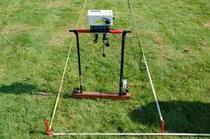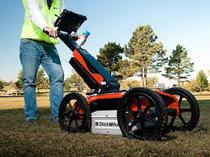
Geophysical Survey Types
Contour Geophysics offer three main types of geophysical survey:
Magnetometry:
Is the technique of measuring and mapping patterns of magnetism in the soil. Ancient activity, particularly burning, leaves magnetic traces that show up even today when detected with the right equipment. Buried features such as ditches or pits, when they are filled with burnt or partly burnt materials, can show up clearly and give us an image of sub-surface archaeology.
Soil is a complex build-up of material that is affected by many types of past activity. One of the most common is burning: this can take place for a variety of reasons - deliberately or accidentally; in one location or spread across an area of crop or woodland. Burning permanently changes the magnetic properties of the surrounding soil by altering the magnetism of tiny iron particles. After this soil or stone has been moved, such as by ploughing, earthwork construction or ditch infill, this activity can be traced by looking for variations in soil magnetism against the general background of the earth's magnetic field. An area in which the soil has a slightly different magnetic orientation to the surrounding earth can indicate the presence of sub-surface archaeology. Archaeological features show up as higher or lower readings: deposits containing much burnt material (such as ditch fills) are usually higher; stone walls usually lower.
Resistivity:
is a form of geophysical survey where electrical current is passed through the ground at regular points on a survey grid. Electrical resistance in the soil varies, and is affected by the presence of archaeological features. Buried archaeological features with varying moisture content such as ditches and pits (higher moisture) and stone walls (lower moisture) stand out compared to the soil around them.
Ground Penetrating Radar (GPR):
Is a variation on conventional radar, which sends a radio signal into the soil which is reflected by variations in density below ground. It is very good at detecting the structures of buried masonry structures, and can effectively show holes or voids below ground - it is therefore valuable in finding buried parts of buildings such as crypts, tombs or cellars, and showing up building foundations.



